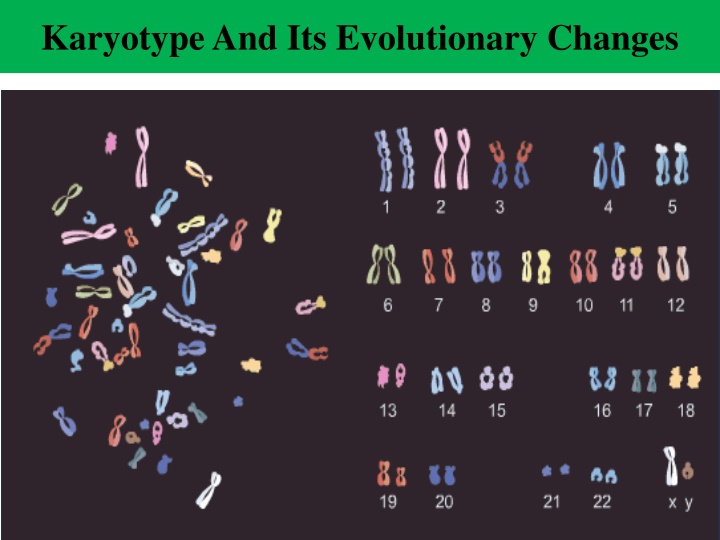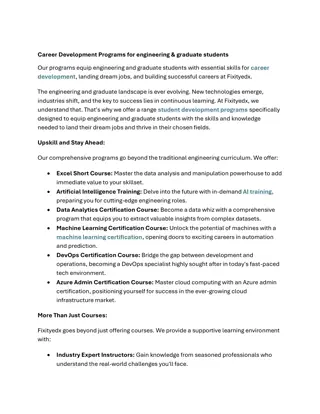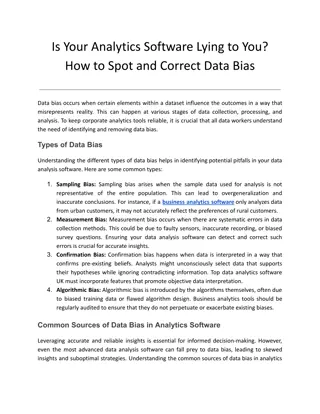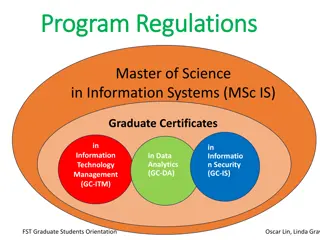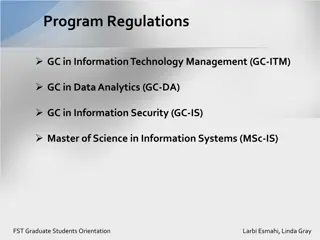Graduate Programs in Information Technology Management and Data Analytics
These graduate programs offer specialized tracks in Information Technology Management, Data Analytics, and Information Security. Each program has unique residency requirements, core courses, and elective options designed to prepare students for diverse career opportunities in the field of information systems. The Master of Science in Information Systems provides a comprehensive curriculum with foundation courses, core subjects, and elective choices for a well-rounded education in this dynamic field.
Download Presentation

Please find below an Image/Link to download the presentation.
The content on the website is provided AS IS for your information and personal use only. It may not be sold, licensed, or shared on other websites without obtaining consent from the author.If you encounter any issues during the download, it is possible that the publisher has removed the file from their server.
You are allowed to download the files provided on this website for personal or commercial use, subject to the condition that they are used lawfully. All files are the property of their respective owners.
The content on the website is provided AS IS for your information and personal use only. It may not be sold, licensed, or shared on other websites without obtaining consent from the author.
E N D
Presentation Transcript
Why do scientists look at chromosomes? Scientists can diagnose or predict genetic disorders by looking at chromosomes. This kind of analysis is used in prenatal testing and in diagnosing certain disorders, such as Down syndrome, or in diagnosing a specific types of leukemia. MOLECULAR BIOLOGY
What is a Karyotype? A display / photomicrograph of an individual s somatic-cell metaphase chrs are arranged in a standard sequence (based on number, size, type) To analyze chromosomes, cell biologists photograph cells in mitosis =fully condensed and easy to see (usually in metaphase). Chromosomes are then arranged in homolog pairs. The homologous pairs are then placed in order of descending size. sex chrs are placed at the end. They are numbered according to size A picture of chromosomes arranged in this way is known as a karyotype. The karyotype is a result of a haploid sperm (23 chrs) fertilizing a haploid egg (23 chromosomes).
Preparing a karyotype harvest cells culture cells 1-2 days arrest cells in metaphase with colchicine spread cells on slide and stain count chrs in 20 representative cells capture image of 5 best cells photograph is taken or the analysis is done by a computer. construct karyotypes for each Chromosomes are arranged in a standard presentation format of longest to shortest. metaphase
Labeling a Karyotype Arm Region Band Subband To label a karyotype correctly, first list the number of chromosomes found in the karyotype. Ex. 46 Secondly, list the type of sex chromosomes found in the karyotype. Ex. XX Lastly, list the any abnormalities at the appropriate chromosome number. 3 2 2 1 2 2 1 p 1 5 1 4 1 3 2 1 1 17q11.2 2 1 1 3 1 2 2 q 3 1 3 2, 3 4 1 2 2 4 3 Chromosome 17
The Karyotype: an international description total number of chromosomes, sex chromosome constitution, anomalies/variants. 46,XY 47,XX,+21 47,XXX 69,XXY Trisomy 21 (Down syndrome) Triple X syndrome Triploidy 45,XX,der(13;14)(p11;q11) 46,XY,t(2;4)(p12;q12) Robertsonian translocation Reciprocal translocation 46,XX,del(5)(p25) 46,XX,dup(2)(p13p22) 46,XY,inv(11)(p15q14) 46,XY,fra(X)(q27.3) 46,XY/47,XXY Deletion tip of chromosome 5 Duplication of part of short arm Chr 2 Pericentric inversion chromosome 11 Fragile X syndrome Mosaicism normal/Klinefelter syndrome
Nomenclature of cytogenetic bands. The ideograms show ideal G-banding patterns at 550 band resolution. Major bands are labelled 1,2,3, etc., going from centromere to telomere. Major band 11q1 (11q means the long arm of chromosome 11, 11p the short arm) is divided into sub-bands 11q11 11q14, and at the highest resolution 11q14 splits into 11q14.1 11q14.3.
How Do Scientists Identify Chromosomes? Three key features to identify their similarities and differences: Size. This is the easiest way to tell two different chromosomes apart. Banding pattern. The size and location of Giemsa bands on chromosomes make each chromosome pair unique. Centromere position. Centromeres are regions in chromosomes that appear as a constriction. Using these key features, scientists match up the 23 pairs
In metacentric chromosomes, the centromere lies near the center of the chromosome. Submetacentric & very Submetacentric chromosomes, have a centromere that is off-center, so that one chromosome arm is longer than the other. In acrocentric chromosomes, the centromere resides very near one end. Mazen Zaharna Molecular Biology 1/2009
Chromosome Groups Group Chromosomes Description A 1 3 Largest; 1 and 3 are metacentric but 2 is submetacentric B 4,5 Large; submetacentric with two arms very different in size C 6 12,X Medium size; submetacentric D 13 15 Medium size; acrocentric with satellites E 16 18 Small; 16 is metacentric but 17 and 18 are submetacentric F 19,20 Small; metacentric G 21,22,Y Small; acrocentric, with satellites on 21 and 22 but not on the Y Autosomes are numbered from largest to smallest, except that chromosome 21 is smaller than chromosome 22.
Patau Edwards Turner, Klinefelter Down
Applications of karyotypes To identify genes that contribute to the chromosome-related syndromes In systematic and phylogenetic studies For example, humans 2n = 46, chimps 2n = 48 9 pericentric inversions + 1 centric fusion Humans differ from closest relatives by 9 pericentric inversions and 1 centric fusion
Humans and great apes 9 pericentric inversions, and one reciprocal translocaton from Yunis & Prakash (1982) Science 215, 1525-1530.
